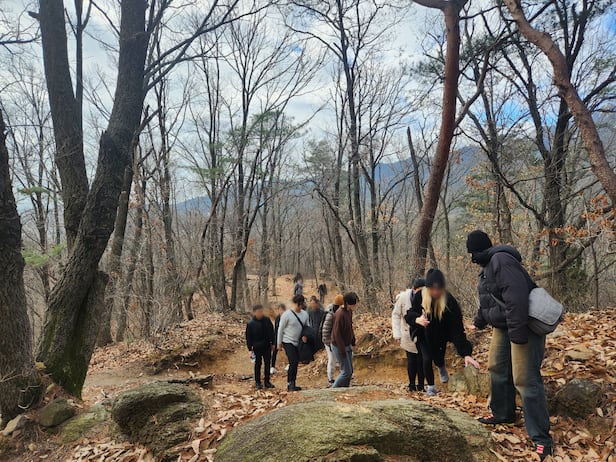
On a chilly December morning, a group of foreigners dressed in mountaineering gear stood in front of the entrance to Bukhansan National Park, an 835.6-meter mountain on the northern periphery of Seoul. The crispy weather with 3 degree Celcisus didn’t stop the foreigners wrapped themselves up with not only mufflers and knit caps from mountain-climbing.
“One, two, three, four!” Their chants, followed by warm-up exercises preparing for a 2-hour round trip climb to Wontongsa temple, filled the open field.
Various different languages mixed as 13 foreigners from Canada, Chile, Denmark, Germany, Kyrgyzstan, Malaysia, the Philippines, the U.K and the U.S followed the chants while stretching.
Lomee, a 19-year-old tourist from the Netherlands, said, “As there is no mountain in my country, it is unique that tourists can easily go hiking in the cities in Korea.” She added, “It also helps that Korea is a safe country where even a female tourist can also go hiking by themselves.”
See Vee, a 35-year-old Malaysian temporarily living in Korea, said “Mountain climbing in Korea is a cultural experience in Korea as foreigners get to explore nature and also visit cultural sites such as Buddist temples in the mountains.”
As K-Pop and K-food are captivating foreigners in Korea, there is a growing expectation that ‘K-Mountain’ will be Korea’s next signature tourism product. The Seoul Metropolitan Government is trying to turn Seoul’s urban mountains into its main travel destinations by operating mountain climbing programs for foreigners.
The key is to increase accessibility so that foreign tourists visiting Seoul on a short trip can easily enjoy mountain climbing. Seoul Hiking Tourism Center, a center which Seoul Tourism Organization opened in June last year near Bukhansan trail, is leading this move.
The center provides hiking information in English, Chinese and Japanese. It also rents climbing equipment such as hiking boots, poles, and crampons to hikers for around $3.83 (5000 won). It ran 47 hiking tours every Wednesday this year in which foreigners can go mountain climbing in Seoul following the lead of a professional guide.
The statistics prove the popularity of urban climbing in Seoul. According to the organization, a total of 9500 people visited Seoul Hiking Tourism Center as of December.
Among them, 4613 foreigners participated in the hiking programs.As of October, nationalities of foreign visitors consist of the U.S (14.2%), Singapore (12.3%), China (8.2%), France (6.8%), the Philippines (4.3%) and more. 54% of them are in their 20s and 30.5% are in their 30s.
Accessibility is the key to K-mountains’ popularity. A representative from Seoul Tourism Organization said “It only takes 30 minutes from the center of Seoul to reach the entrance of the main mountain trail such as Inwangsan Mountain by public transportation such as bus or subway.”
Foreigners say it’s rare for mountains over 200 meters high to be located close to a touristy city center. The infrastructure of safety fences, clean toilets, and such also attract foreigners to Korean mountains.
Marcelena, a 40-year-old tourist from Chile, said, “It takes over 7 hours to go to the nearest mountain for hiking in my hometown, and there is no accessible public transportation,” and added, “Even if I get there, the trails are dangerous, and there are no well-maintained facilities.”
As mountain climbing becomes more popular, more foreigners demand information in their own language.
In response to this demand, Airbnb and Seoul Tourism Organization opened an English website introducing basic Seoul mountain hiking information on Dec. 1. The website provides information on hiking trails, hiking etiquette, Airbnb accommodations to stay near the mountains and more.
Eum Sung-won, Head of Comms for Northeast Asia at Airbnb, said “We plan to contribute to Korea’s tourism industry by making Korean mountains accessible to foreigners interested in hiking in Seoul.”


